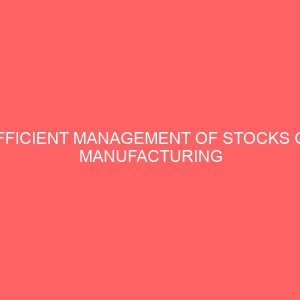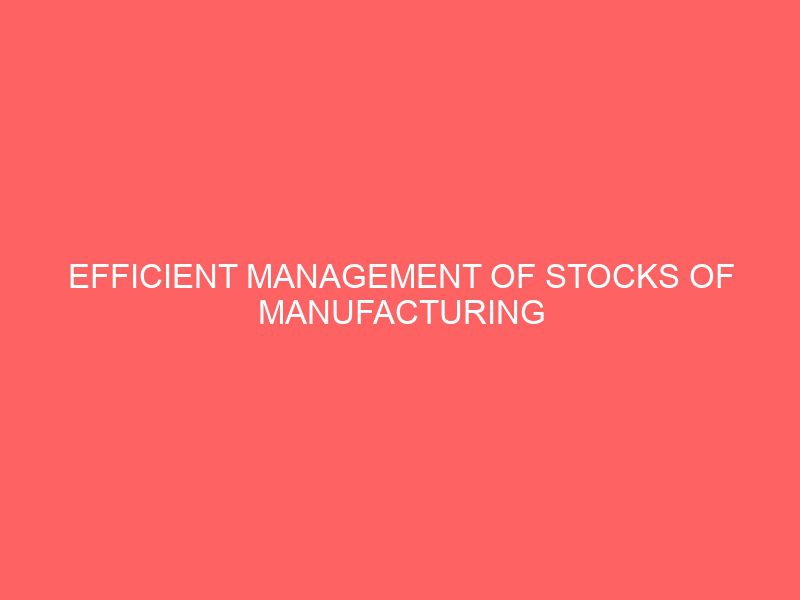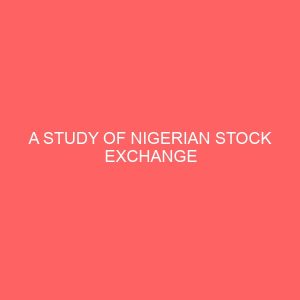Description
THIS RESEARCH WORK IS ON EFFICIENT MANAGEMENT OF STOCKS OF MANUFACTURING COMPANIES
ABSTRACT
Stocks otherwise referred to as inventories by enterprises and usually comprise, raw materials; and supplies used in Production work-in-progress and finished goods stocks also include livestock awaiting safe supplies to be consumed in the production of goods or the rendering of services. The researcher project is aimed at knowing the role for efficient stock management in a manufacturing company. The management of various companies is faced with the problem of at what level should be held in order to have a healthy operation that is optimal that will minimize the cost of stocks the (ordering and holding costs). Therefore, the problems of stock management revolve on the determination of optional company. The optimal stock level varies from one company to another depending on the company on the volume of operation. In other to achieve the objective of the research, Anambra Motor Manufacturing Company Limited (ANAMMCO) Emene is used as a case study.
CHAPTER ONE
INTRODUCTION
1.1 Background of the Study
Inventories refer to the stock of resources that possess economic value held by an organization or company of any point in time. These resource stocks can be manpower, machines, capital goods or materials of various stages.
The various components of stocks are raw materials work in progress and finished goods. Raw materials are these basic input materials and components that are scheduled for use in making a product. Work in progress are materials that have begun their transformation to finished goods, they represent product for sale. finished goods are goods ready for sale to customers. Stocks of raw material and work-in-progress facilitate production while stock of finished goods is required for smooth marketing operation. Manufacturing form will have substantially high level of all the three kinds of inventory. While wholesale and retail form will have a very high level of finished goods.
Inventory known as “Inventory supplies”. These includes fuel, light bulbs, cleaning materials, these do not directly enter into production process, but are necessary for production. Sophisticated system of inventory was not maintained for it, because not much funds were committed into it.
Considering the large amount of money spent on these stocks, care must be taken in managing it efficiently in order to avoid jeopardizing its long run profitability and failure. In order to avoid this risk, company must install a sound stock management system.
Anambra motor manufacturing company ltd was conceived in the 1978 as a joint venture between federal government of Nigeria and Dailmer Benz AG of Germany for the setting of a manufacturing plant for the assembly of Mercedes vehicles using completely knocked Down parts (CKP)s with its factory location at Emene Enugu State. The federal government of Nigeria led 35% of the shares, Damiler Benz AG had 40% and other Nigerian investors consisting mainly of state government of the old East Central State and few other investors held the remaining 25% of the company’s equity.
The foundation stone of Anammco was laid by the military Governor of Anambra State, Col. John Atomkpera on May 12, 1978. ANAMMCO Training Centre was commissioned by the federal minister of Education Hon. Sylvester Ugoh, on April 26 1982. ANAMMCO central spare parts depot was opened on October 1985.The company commenced full production on January 1986. These installed production capacity on shift for annum was seven thousand, five hundred commercial vehicles.
This multi-million plant which is sifted on 300,000 square meters site at Emene near Enugu was built by joint partnership agreement between federal government of Nigeria and Daimler-Benz AG of Germany to produce Mercedes trusts to met Nigeria increasing demands for commercial vehicles. Anammco is therefore a logical development of that long pioneering tradition of Mercedes Benz sales and services through Nigeria.
Anammco was incorporated as a limited liability company on January 17, 1997, in 2007 federal Government on Nigeria sold 24% of its shares to G.U. Okeke & Sons limited Whilst DAMILER – BENZ AG sold 40% of it’s shares to AFFREECAL LIMITED, currently the major shareholders of the company are ATFREECAL LTD having 40-45% G.U. Okeke and sons limited 27 – 45%. Federal Government of Nigeria through the B.P.E. having 11% several state Government and few private investor held the remainder of the shares.
The following people were members of the Board of Directors of ANAMMCO Chief G.U. Okeke chairman, Mr. Onken, Mr. Uche Okeke, Igwe Onyia, and Obi Charles C. Olutala C. with over 1200 workers including Nigerians and foreign experts and technicians who made up less than 3% of the total workforce.
1.2 STATEMENT OF PROBLEM
1. In ANAMMCO, the greatest problem of stocking is under stocking. As a result of importing of spare parts from Germany.
2. There is no proper record of stock taking and stock valuation. Parts are removed and returned to shore without proper authorization.
3. Once stock is not properly taken care of through proper authorization, and management, the value of the company’s current asset will not be properly documented.
4. To make sure that the form does not run out of stock which will in turn affect their profit, it will be necessary that stock should be well managed and this lead to proper information on when to order for new parts and how the parts were used.
1.3 THE OBJECTIVE OF THE STUDY
The prime objectives of this research work are:
1. Finding solution to the problem of managing and controlling stock in the manufacturing company.
2. Determination of the effects of inefficient stock management on the profit of the company.
3. Whether these is divergence between, policy and practice in the stock management at ANAMMCO.
1.4 RESEARCH HYPOTHESIS
1. Hypothesis one:
Ho: The problem of under stocking in ANAMMCO does not lead to maximum production capacity of the factory as well as reduction in profit.
Hi: The problem of under stocking in ANAMMCO does not lead to underultilization of installed capacity and production of company’s profit.
Hypothesis two:
Ho: Improper stock management and valuation does not lead loss of stock and inaccurate balance sheet.
Hi: Improper stock management and valuation lead loss of stock and inaccurate balance sheet.
Hypothesis three:
Ho: Improper management of stock does not distort information flow in an organization and proper ordering of the parts.
Hi: Improper management of stock distorts information flow in an organization and proper ordering of the parts.
1.5 SIGNIFICATION OF THE STUDY
The importance of this study to manufacturing concern in general, and Anambra Motor manufacturing company (ANAMMCO) in particular is to find solution to this. Itching problem of how much the business can afford to invest in stocks without adverse financial effects on the company’s profitability? Since companies have some many other operation needing. Money investing too much on stock means that there will DC letters or no funds to meet the expenditures on these operations. Therefore these is the need for the manufacturing companies to invest wisely on stock.
The stock will also help the manufacturing companies to grow against risk or losses through the following:
1. Determination and Evaporation materials, which easily deteriorate, should be properly stock to avoid loss of money. The rate of wage should determine the amount to store and where necessary special containers to prevent deterioration should be used for storing.
2. Change in fashion taste should be taken to overstock items that can be easily rendered useless due to fashion changes as this will result to heavy losses to the company.
3. Change in price in the stock holding can be ascertained through the changes in prices of stock. Stocks are built if prices are anticipated to be high. Similarly any expected full in price will be to the management to reduce the stock.
4. The successful completion of the study will add to the available data on this topic. Therefore subsequent writers can reach out for any information concerning the topic.
1.6 SCOPE AND LIMITATION OF THE STUDY
This study is to analyze the need for efficient management of stocks of manufacturing companies in general but with particular reference to ANAMMCO. This is with the view of finding out how the company has been able to manage her stock in line with the achievement of her objectives.
In the analysis, the writer focused on the investment in show. The stock comprises, stock of raw material, working in progress and finished goods. Stock of suppliers was not incorporated in the study due to time factors. This study did not go into comparisons with others motor manufacturing companies (like Peugeot Assembly of Nigeria and Volkswagen Nig. Ltd) this was as a result of time and financial constraints although information relating to the stock of the companies was gathered. Management of the company regards some information as being private and exclusive; therefore the writer has derived these information and data.
Because of this, the researcher could not as much detailed analysis as he would have liked into stock management at the company.
1.7 DEFINITION OF TERMS
Some technical words are used by the researcher which is purely related to the topic. These technical words are explained as follows:
Ordering cost:
This cost represents both the clerical and secretarial costs, involved in preparing an order and receiving relevant documents. If materials are ordered for in small batches, the unit ordering cost will be high and if the order is in large batch, the unit ordering will be low.
Carrying cost:
Carrying cost of a desired rate of return on the investment in inventory and costs of storage spaces, breakage obsolesce, deterioration and insurance and personal property taxes.
Minimum Levels:
It represents the order point where it is necessary to place an order to increase the quantity of stocks of the organization to the maximum level. This is done to ensure no “stock out” situation and no waste situation or materials and there keeping the cost at the minimum level.
Re-ordering level system
This is a method in which a predetermined re-orders level set for each item of materials.
Maximum level method
This is the highest quantity of stocks, which the organization should not go beyond.
Economic Order Quantity
It is that quantity which minimizes the balance of cost between inventory holding cost and ordering cost.
Lead time:
Lead-time is the length of time between when an order is placed and the time the goods are received.
Safety Stock
This is the stock set aside to meet the demand of the customers in case of raw materials, in case there is sudden usage beyond the normal usage. The aim of safety stock is to make sure that the company does not run out of stock at any time. project topics on manufacturing companies, project topics on stocks market
Stock
A quantity of something that is kept or stored for use as the work-in-progress, finished goods or supplies. Need arises, especially a quantity of raw materials.
Stock control
Activity, process or study of stock ensuring that quantity of stocks (e.g. of materials supplies or finished goods) are such that satisfactory services level is maintained for all stock keeping units, while holding cost is minimized.
Stock Holder
A firm of a person who has a specified type of stock (e.g. a whole seller that has stock of a particular manufacturer’s goods).
Value Analysis
Consideration of the function of all parts of the design of one of a firm’s product to see whether any changes in materials manufacturing methods or design will increase the products value of the firm obsolesce.
The decline in value of asset through external causes such as technological change or changes in demand.








Reviews
There are no reviews yet.